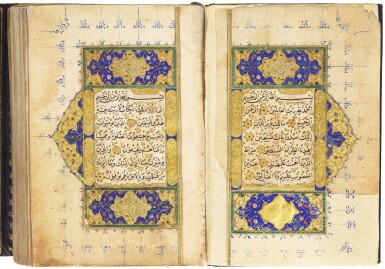THE SHAKERINE COLLECTION: Calligraphy in Qur’ans and other Manuscripts
THE SHAKERINE COLLECTION: Calligraphy in Qur’ans and other Manuscripts

AN ILLUMINATED QUR’AN, COPIED BY SULEYMAN, STUDENT OF SELANIKI, TURKEY, OTTOMAN, CIRCA 1600
Auction Closed
October 23, 11:03 AM GMT
Estimate
8,000 - 12,000 GBP
Lot Details
Description
AN ILLUMINATED QUR’AN, COPIED BY SULEYMAN, STUDENT OF SELANIKI, TURKEY, OTTOMAN, CIRCA 1600
Arabic manuscript on paper, 427 leaves plus 4 fly-leaves, 13 lines to the page, written in naskh in black ink, ruled in black and gold, verses separated by gold and polychrome rosettes, surah headings in gold riqa outlined in black against a blue foliated ground within cartouches, hisb, nisb, ‘ashr and sajdahs with gold markers in the margins, f.1b and f.2a with an illuminated frontispiece, f.427b with a gold finispiece roundel, in brown gilt and stamped leather binding, with flap
text panel: 7.8 by 4.5cm.
leaf: 11.6 by 7.8cm.
Christie’s London, 16 October 1980, lot 12.
N. Safwat, A Collector’s Eye. Islamic calligraphy in Qur’ans and other manuscripts, London 2010, no.26, pp.120-1.
Thanks to the colophon, we know that the master of the present scribe Suleyman was from Thessaloniki (Selaniki). Three calligraphers are known to have been from Thessaloniki: Mahmud, his son Ahmed and Mustafa ibn Nusuh (Safwat 2010, p.120), although the current scribe doesn’t clarify who his teacher was. The opening illumination is typical of the late sixteenth/early seventeenth century. A Qur’an with a similar frontispiece, dated 977 AH/1569 AD, is published in Derman 2010, pp.84-85.
